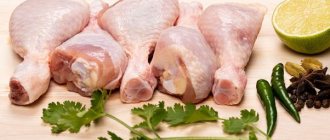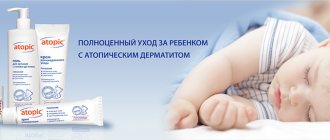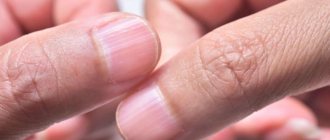General recommendations for creating a menu for atopic dermatitis
An allergy or hypersensitivity reaction is a specific condition of the body that occurs upon contact with certain substances, allergens.
They enter the bloodstream and lead to the appearance of extensive red spots and rashes on the skin, which may be accompanied by itching and fever.
To prevent such a reaction, it is recommended to introduce certain restrictions into the child’s diet.
What are the general recommendations when creating a menu for a baby with this disease:
- It is worth excluding potentially dangerous products that can lead to allergies, such as various canned foods, marinades rich in vinegar and spices, semi-finished products whose composition is unclear, and mushrooms.
- Limit the consumption of fatty and unhealthy foods: pork, chicken, eggs, even sawn eggs will be prohibited.
- Red vegetables and fruits are also dangerous for children with a similar diagnosis; they can lead to skin rashes.
- Dairy products with a high level of fat are not recommended for dermatitis and can cause harm to the body.
- Baked goods, sweets and snacks, they are rich in harmful substances, irritate the mucous membrane of the stomach and intestines and contribute to the accumulation of toxins.
- Carbonated drinks and packaged juices are prohibited for children of all ages, as they overload the gastrointestinal tract and liver.
Three basic rules to follow when following a diet.
Table 1. Diet rules
| First: | It is worth eating fresh and natural foods. Carefully monitor expiration dates. |
| Second: | Eliminate sugar and foods containing it in high concentrations, partially replace them with fructose. |
| Third: | Keep a diary to track your reactions to food. |
It is advisable to consult a doctor when creating a menu; he will help you eliminate foods that can lead to similar problems.
Atopic dermatitis in a child: symptoms and treatment
Atopic dermatitis in infants easily worsens after a short recovery if you do not properly care for the delicate skin and treat it incorrectly for dryness and itching. Let's figure out what to apply to atopic skin and what products to avoid so as not to provoke an exacerbation. The therapist, allergist Tatyana Nikolaevna Dzyaduk tells the story.
— Tatyana Nikolaevna, how does atopic dermatitis in children differ from other types of dermatitis and allergies?
— Dermatitis is any inflammation of the skin. Atopic dermatitis is a specific diagnosis: it is a genetically determined chronic and itchy inflammation of the skin. Atopic dermatitis and allergies are two completely different diseases, in most cases unrelated. But if they are present in one child, then the allergy can aggravate the course of atopic dermatitis.
— Let's talk about atopic dermatitis in newborns and infants. Why does it still arise?
— The causes of the disease are related to the work of genes. And first of all, the filaggrin gene, thanks to which in a healthy person the skin is impermeable to water, bacteria and allergens. When this gene is mutated, the epithelial cells do not fit tightly together, the skin is loose, like a sieve. It quickly loses moisture, becomes very dry and sensitive, and various allergens and microorganisms easily penetrate through it.
Thin children's skin is especially sensitive. At the same time, the sebaceous glands in young children do not yet produce sebum in quantities sufficient to naturally moisturize the skin and create a protective film. Therefore, it is in children that the symptoms of atopic dermatitis are most pronounced.
— The disease can debut in the first month of life, most often at 2-4 weeks in severe cases. A child is born with healthy skin, since in the womb it is not affected by external factors, but subsequently water, dry air, clothing, and chemicals affect the skin, which becomes dry and irritated. And the stronger the filaggrin protein defect in the skin, the earlier atopic dermatitis appears.
— What does atopic dermatitis look like?
— The main problem is dryness. The baby's skin becomes covered with dry plaques and peels, and he is bothered by severe itching. With age, plaques will change location.
Sites of skin lesions in atopic dermatitis
In children under 2 years of age:
| In older children:
| In adults:
|
— Is a diet always prescribed for atopic dermatitis?
— The presence of atopic dermatitis has nothing to do with the child’s nutrition. In case of atopic dermatitis, aggravated by an allergy to cow's milk proteins, feeding a child with products containing this protein can cause an exacerbation of dermatitis.
How often are atopic children associated with food allergies:
- with a mild course - less than 5%;
- with moderate severity - 10-20%;
- for severe cases - approximately 30%.
The connection between atopic dermatitis and allergies accounts for less than a third of all cases. And if the child is not allergic to cow’s milk proteins, then atopic dermatitis will proceed in the same way on artificial and breastfeeding.
- The introduction of complementary foods can also provoke an exacerbation. And most often, histamine-releasing products are to blame for this: some vegetables and fruits in complementary foods contain histamine, which causes a skin reaction. In addition, children often smear food on themselves, which is why fruit acids begin to irritate the skin of their hands, face and cheeks. And if a child does have a food allergy, then introducing an allergen into complementary foods can cause dermatitis.
Atopic dermatitis and food allergies
| The most active food allergens up to a year | Cow's milk protein and chicken egg: if they are present in complementary foods, and the child is allergic to them, then the dermatitis will worsen. |
| Allergies during breastfeeding | If a breastfeeding mother eats foods to which the baby is allergic, the dermatitis will worsen. |
| Allergy during artificial feeding | If you have an allergic reaction to cow's milk protein, regular infant formula is not suitable. The child is given a mixture of high hydrolysis, in which the protein is maximally broken down into amino acids, or an amino acid mixture, which contains only amino acids. |
| Diet for atopic dermatitis | If the doctor has diagnosed a food allergy and identified its connection with dermatitis, then the allergenic product is completely excluded from the child’s diet or from the diet of the nursing mother. The timing and type of diet is determined by an allergist: usually this is at least 6 months, and in severe cases - up to 1.5 years before the trial administration. |
Video about food allergies and atopic dermatitis
- What is the diagnosis of atopic dermatitis?
— The doctor makes the diagnosis of “atopic dermatitis” after a visual examination of the child. There are no specific laboratory tests. Theoretically, you can undergo a genetic examination for the presence of a gene defect, but it will not be a criterion for making a diagnosis, because the diagnosis is the symptoms, that is, what is visible to the eye. You can test your child for concomitant food allergies, but this is not a diagnosis of dermatitis.
Elimination diet for atopic dermatitis
It is difficult for children to tolerate strict dietary restrictions; a growing body needs nutrients and minerals.
It is recommended for such children:
- gradually introduce new products to the menu, monitoring the reaction;
- At first, limit the consumption of meat, fermented milk and other dishes.
They start with porridges, cereals and low-fat meat broths, which are easily absorbed by the body and do not cause digestive problems.
Gradually, new products are added to the diet, carefully monitoring the body's reaction to their use. It is better to fix the menu, write down everything that the baby eats. If an inadequate reaction occurs, the product is removed.
Rotation diet for atopic dermatitis
It has a different principle, it consists in observing the following rules:
- The menu is designed in such a way that a new product appears on it at least once every 4 days.
- A menu is created for the day from one type of meat, cereal, and vegetables.
- If a child develops an allergy, then after 5 days a new product is given in combination with others.
- The reaction is repeated - completely excluded from the diet.
This diet will help identify the allergen; it is suitable for those children who, according to their parents, react “to everything.”
Diagnostic diet
Currently, there is no single generally accepted diagnostic test on the basis of which a diagnosis of PA can be made. The diagnosis is established on the basis of the clinical picture, the results of an allergological examination with food allergens, as well as on the basis of the complete disappearance of symptoms after prescribing a diet with the exclusion of the product from the diet (elimination diet).
When a child has symptoms and there is a high probability of an allergy (for example, an allergy in parents or close relatives), a diagnostic elimination diet is prescribed to exclude foods containing this protein. When breastfeeding, such foods are excluded from the mother's diet.
The duration of the diet may range from 3–5 days in children with immediate reactions (eg, swelling, vomiting, skin manifestations within 2 hours) to 1–2 weeks or more in children with delayed or chronic reactions (eg, atopic dermatitis). If the child has gastrointestinal symptoms (eg, enterocolitis), it may take up to 4 weeks to evaluate the results of the diet. Keeping a food diary is of great benefit during this time.
If an allergy to CMP is suspected, a diagnostic dairy-free diet is prescribed. The effectiveness of such a diet can be assessed within 2–4 weeks, depending on the nature of the reactions (immediate or delayed type) and the nature of the allergy (acute or chronic process).
Table of allergenicity of products from the Union of Pediatricians
If we talk about the allergenicity of food products, then it largely depends on the body’s susceptibility to food allergens. But there are general recommendations that the Union of Pediatricians recommends following.
Table 2. Permitted and prohibited products
| What you can't eat: | It is possible, but in moderation: | Allowed: |
| Fatty and spicy dishes, spiced cheeses, pickled delicacies. | Whole milk and butter. | Bread made from rye flour. |
| Confectionery and chocolate, as well as desserts with high cocoa content. | Cornflakes. | Cereals: buckwheat, lentils, rice (you will have to soak it first), oatmeal. |
| Mushrooms in any form. | Semolina, white bread. | Lean meat: preference is given to rabbit, lamb, veal, you can include beef tenderloin in the diet. |
| Baked goods made from refined flour, sugar. | Onions and cucumbers. | Olive oil, white cabbage and broccoli. |
| Exotic fruits, fruits and vegetables of red and orange color. | Cranberries, sea buckthorn and other berries are red or yellow. | Zucchini stewed or baked. |
| Honey, nuts, most dried fruits, citrus fruits. Margarine and its contents, mayonnaise and other fatty sauces. | Sawing eggs. | White or green apples. |
| Smoked, canned and salted fish, meat, store-bought convenience foods, carbonated drinks. | Pasta made from durum wheat. | Cottage cheese, kefir, fermented baked milk with low fat content. |
More often, skin rashes appear after eating honey, nuts, red fruits, and citrus fruits. This reaction is also observed when fish dishes are included in the menu. It is rich in mercury, which accumulates under the fins and gills. Therefore, children with atopic dermatitis who are forced to follow a diet do not have fish or seafood in their diet.
Nutrition for a nursing mother with a child allergic to cow's milk
Excluded:
- all products containing protein from cow's milk and the milk of other mammals, beef;
- eggs, peanuts, nuts, fish, seafood, soy;
- products that often cause both allergic and non-immune (“false allergic”) reactions (caviar, mushrooms, honey, chocolate, coffee, cocoa, citrus fruits, kiwi, pineapples, avocados);
- broths, marinades, salty and spicy dishes, canned food, smoked meat and fish, spices; products containing artificial colors, flavors, preservatives;
- carbonated drinks, kvass;
- sauerkraut, radishes, radishes, fermented cheeses, ham, sausages, smoked meats, pickles, marinades and other products that cause the production of histamine;
- products that irritate the gastrointestinal tract and change the taste of milk - onions, garlic, radishes, radishes.
Allowed (subject to portability):
- vegetables and fruits (mostly green, white);
- vegetarian soups; meat - lean pork, turkey fillet, rabbit in boiled, stewed form, and also in the form of steamed cutlets;
- cereals (buckwheat, corn, rice, oatmeal, millet, pearl barley);
- pasta;
- bread - 2nd grade wheat, wheat-rye;
- vegetable oils, ghee;
- tea, compotes, fruit drinks from dimly colored fruits.
If breastfeeding is maintained, a complete diet for the mother should be prepared and calcium supplements prescribed. To maintain the protein part of the diet, you can use medicinal mixtures based on amino acids.
It is necessary to exclude allergens, including cow's milk protein, from the diet of the child and/or mother for at least 6 months. However, after the acute symptoms of allergy in the child disappear, the mother’s diet can gradually expand under the control of tolerance to other foods.
Breastfed infants with severe manifestations of PA (for example, severe atopic dermatitis or allergic enterocolitis with growth retardation and/or severe anemia) can be temporarily excluded from breast milk and prescribed a therapeutic mixture of amino acids or highly hydrolyzed protein for 2 weeks.
Cross-reactivity of some products
What is compatibility and what products are best combined with each other?
Table 3. Product compatibility
| Pasta and potatoes: | Combine with lean meat, boiled or stewed. You can add a little cheese. |
| Dairy products: | We combine kefir or natural yogurt with apples; you can eat it with rye flour bread. |
| Vegetable stew: | They go well with boiled meat; you can bake foods together. |
| Cereals: | We successfully combine them with milk and add a little butter. |
You should not combine cereals with meat, cheese, and pasta with butter; it is better to use olive oil.
The most allergenic and safest products for children with atopic dermatitis
When compiling a diet, the degree of safety and danger of products is taken into account; the indicators are shown in Table 4.
Table 4
| Dangerous: | Safe products: |
| Honey, chocolate, nuts, seafood, oranges, tangerines, kiwi, pineapple, watermelon, melon, eggs. Red berries. Various spices and herbs, caviar. | Kefir, low fat, rabbit, turkey or veal. Cabbage, buckwheat, rye flour bread. Cottage cheese, green apples. |
Dangerous foods are excluded from the diet in any case, since when they are consumed, there is a high probability of developing a hypersensitivity reaction. But when consuming safe ones, such problems do not arise.
Diet for adults and teenagers
There are no serious differences and consists in following basic rules. Food allergies occur more often in children than in adolescents and adults.
What should be excluded from the diet:
- coffee and drinks containing high concentrations of caffeine;
- strong tea with herbs and berries - can lead to a rash on the body;
- various types of alcohol, since its consumption leads to the accumulation of toxins and harmful substances;
- bakery and pasta products made from refined flour;
- various sushi, snacks rich in herbs and spices are also prohibited.
Over the years, with the correct menu design, it will be possible to remove from the diet those foods that are most dangerous for humans. So, teenagers and adults are not prohibited from eating carrots, bananas, soybeans, and potatoes. They are conditionally safe for the body. But they are prohibited for children.
Disputes also arise regarding cheeses; preference is given to those that are not high in fat, but it is better not to give them to children.
Child nutrition
Foods that cause PA are excluded from the child’s diet. When treating allergies in breastfed children, the pediatrician’s task is to preserve breast milk in the child’s diet to the maximum extent possible. If you are allergic to cow's milk proteins, the mother completely excludes all products containing these proteins, beef and veal, from her diet. Often several foods cause a reaction; With such multiple allergies, a nursing woman is prescribed a hypoallergenic diet. At the same time, the severity of the restrictions and the range of products in it are individual and depend on the manifestations of the child and the presence of allergies in the mother.
Diet for pregnant and lactating women
If, during the period of bearing a child, a woman does not monitor her diet, then the risk of the baby developing dermatitis increases. On average it increases by 15-20%.
What foods are prohibited for pregnant and nursing mothers:
- Fatty and fried foods, chocolate and drinks containing caffeine.
- Exotic fruits because they may contain harmful preservatives.
- Carbonated drinks, smoked foods, salty canned food and processed foods will cause swelling and increase blood pressure levels.
- Sweets in large quantities, fatty sauces and pickled dishes, garlic, onions.
- Red and orange fruits and vegetables are often the cause of food allergies.
The diet should be balanced; a woman is recommended to eat food in small portions; if she is very hungry, then have snacks. Drink kefir and eat apples.
Features of cooking porridge
We will cook with milk, with the addition of butter, provided that its fat content does not reach 82.5%. What to do:
- Add milk to the water and add cereal; first soak it and rinse it under running water.
- We wait until the porridge boils and reduce the temperature, bring the dish to readiness, stirring occasionally.
- At the final stage, add salt (just a little), and before serving, add butter.
We must heat-treat the milk and do not add it to ready-made porridge cooked in water. This will increase the risk of developing a lactose allergy.
Soups
We will cook with meat broth, choosing a suitable piece of tenderloin, what to do:
- Boil the meat, drain the water twice during cooking, after boiling;
- then place the vegetables for the soup into the boiling broth, after chopping them;
- remove the meat and let it drain; when the vegetables are almost ready, add it to the soup;
- Add salt a few minutes before the dish is ready, mix everything thoroughly with a wooden spoon.
Using this scheme, you can prepare any soup, taking into account the child’s preferences. We select the ingredients correctly, avoiding red vegetables, which lead to the development of an allergic reaction.
You should not prepare milk soup for a baby with allergic dermatitis; pasta in combination with milk can lead to a rash.
How to introduce complementary foods to a child with atopic dermatitis
By 5-6 months, children need to diversify their diet with new foods. Healthy children are recommended to start supplementing their diet with dairy products. But it is known that the main reason for the development of atopic dermatitis in the first year of life is intolerance to cow's milk. In this case, the doctor may recommend fermented milk mixtures or milk substitutes based on protein hydrolysates. But if the child had a severe allergic reaction to breast milk after feeding his mother with milk, then even fermented milk products (kefir, cottage cheese) are not recommended until 1 year. As for other products, complementary foods for babies with atopic dermatitis are introduced at approximately the same time as for all children.
Complementary feeding scheme
You can start introducing new products during remission, when the skin is clean, perhaps a little dry, and there are no obvious manifestations of dermatitis. Products are added to the diet gradually, one per week or every 10 days - 2 weeks. All the child’s reactions to new food are recorded in a “Food Diary”. The first feeding dish is a vegetable baby food made from white or green vegetables. You should avoid pureed vegetables that are red or orange in color. The first portion should be the size of 1 teaspoon, and it is best to offer it to your child for breakfast. Gradually, over 1 week, the volume of product consumed is brought to the norm corresponding to age. First one type of vegetable, then another; you cannot puree several types at once.
If everything went well, the diet is expanded - cereals are added, sometimes dairy-free. Preference is given to buckwheat, rice, oatmeal and corn. It is better not to give semolina porridge to children with atopic dermatitis until at least 1 year of age. You can cook porridge in broth, but not meat, but vegetable. Meat is administered in consultation with the doctor. If a child has been diagnosed with an allergy to cow's milk, then most likely he will have an allergic reaction to beef, so it is better to start with rabbit or turkey meat.
At the age of 8-9 months, you can introduce green fruit puree, in small portions, 1 teaspoon each. It is better to start, for example, with a baked apple, gradually replacing it with raw fruit puree. The choice of drinks should be approached with caution. Until one year of age, it is better not to give your child tea or herbal teas, but to give him clean water. Juices are made from green fruits, and you can use them to make jelly and compotes. It is advisable to limit the amount of sugar used.
It must be remembered that dishes for children with atopic dermatitis require special cooking. For example, meat is boiled twice, grains are soaked for 1-2 hours before cooking, and potatoes are soaked for 12-24 hours. It is better to steam, boil or bake.
At least until the age of 1 year, eggs, nuts (primarily peanuts and peanut butter) and fish, even boiled fish, should not be included in the baby’s diet. These products are among the 8 most common food allergens and can provoke a severe allergic reaction in a child with an “incorrectly” functioning immune system.
Why does diet sometimes not work?
It often seems to parents that a small amount of a product to which the child is allergic will not harm him. This is completely wrong! Even a small amount of such food will render the entire diet useless: the body will need at least 3 weeks to recover from an allergic reaction. Do not forget to keep a “Food Diary”, carefully and accurately recording in it all the changes in the baby’s condition and behavior observed during the introduction of complementary foods.










